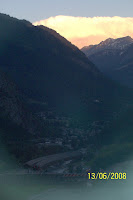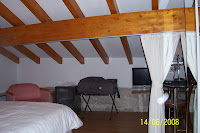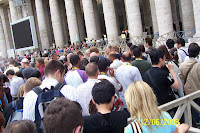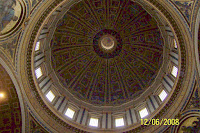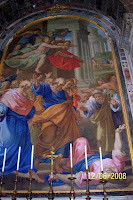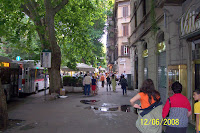(Remember to click on the photos to see them full-sized!)
Geneva isn’t noted as a tourist destination. Its reputation is more on the solid, serious side: banks and financiers and jewellers and headquarters of international organisations.
Nonetheless, we’ve always found plenty to see and do in the most unpromising places, and we were absolutely certain that Geneva would be much the same.

Even so, we slept in this morning, having had a long exhausting day and late night yesterday (and it was the last chance of our holiday to have a lie-in). From our window (covered with wire mesh) we could see a bright, sunny day, and feel a cooling (not cold) breeze.
“Mike” of the previous evening had promised us
petit  déjeuner
déjeuner any time before midday, so we took him at his word. The waitress, though, seemed rather non-plussed at these foreigners demanding breakfast at 11 a.m. on a Saturday. Still, she rallied round, and we broke our fast splendidly before taking her advice and catching the #5 bus (about 12:00) to the
Place Bel Air on an island in the Rhône called “
L’Ile” (!), near where the river flows from Lake Geneva.
(Much as we’d enjoyed fencing with Italian, it was nice to be back in a country where we felt mid-way competent in the language. But
Le  Dictionnaire
Dictionnaire remained our constant companion …
We crossed to the south bank, taking numerous photos, and admiring the famous
Jet d’Eau and the giant inflated soccer ball moored next to it (there were signs of
Les Euros wherever you went in the city).
We were looking for a boat ticketing office; we thought a lake cruise, with

dinner, would be just the thing! Before long we came to a
Départ des Bateaux, where they were advertising cruises of various sorts, but it turned out that we were too late: all tickets for the dinner cruises had already been already sold. We decided we’d think about alternatives before we bought.
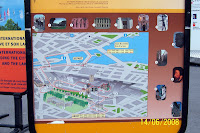
Something we like to do when visiting cities is take the open-top bus tour. We did this in Rome (yesterday and the day before), but “buses” as such are not a feature of Venice (so we did the gondola thing), and the open-top kind don’t seem to be a feature of Geneva. On the way to the
Départ des Bâteaux, though, we passed a placard advertising “train” rides through the
Vieille Ville, the Old City. Tickets were on sale at the
Bâteaux ticket office, so we bought a couple and made our way back to the “train station” in the
Place du Rhône, at the end of the
Pont des Bergues.

The next “
train” was standing at the “station”, but its departure was half an hour away, and there was a café and ice cream shop nearby; so while we were waiting, we had ice creams (chocolate for Margaret, hazelnut for Don; they were excellent) and watched the Euro 2008 crowds enjoying themselves. This passed the time pleasantly until it was time to board the “train” or lose our places; so we climbed aboard.
As the photo of the placard shows, the “train” runs past a fair number of sights (22 in fact), with a good English commentary, and much of the time it runs slowly enough that you can take photos. And we did, far too many to describe or even summarise, so here are just a few highlights.
The first part of the trip was through
Bastion Park, which was once the botanical garden of Geneva’s first University. It was a sunny Saturday, and the park was full of people enjoying themselves at the giant chessboard, or throwing balls or Frisbees on the grass, or picnicking in the shade (and shelter if it rained) of the pavilions that had been erected for (presumably) that purpose. Here, too, was the
Reformer’s Wall, more formally the
Monument international de la Réformation, with bas-reliefs of the leaders of the Reformation movement (Calvin, Beza, Knox, and others).

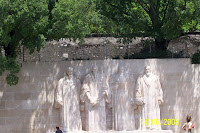

The
Vieille Ville is a small but wonderful maze of cobblestoned streets at various elevations,


where we saw everyday Genevans relaxing at open-air restaurants in the city squares on a sunny Saturday afternoon (photo left). There was also the
Barbier Mueller Museum, the
Maison Tavel (Geneva’s oldest house), children on a seesaw atop the town wall (photo right), the austerity of St Peter’s Cathedral, restaurant-goers wining and dining in the shade of the trees on Rousseau’s Island …
Back at the
Place du Rhône, we decided that we’d enjoyed the
Vieille Ville tour so much, we’d
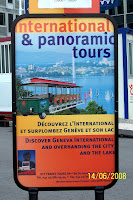
also try the “International and Panoramic Tour”, which was by “mini-tram” rather than “mini-train”. How could we resist the offer to “Discover Geneva International and Overhanding the City and the Lake”? But again

the next departure was a little way away, so we went back for more ice creams. The shop had a stunning array of flavours, about 16, we reckon, plus about eight flavours of sorbet, so this time Margaret tried the hazelnut while Don tried
sorbet du citron vert (lime). While waiting, we watched youngsters playing mini-soccer (Euro 2008 fever!) in a street-side enclosure, and made use of the nearby Portaloos—an unexpected side-benefit of the city’s being full of sports-minded visitors (no hunting for loos)!
The “International and Panoramic” tour, in the event, was not noticeably

international, though it did take in the
Jardin(s) (des) Anglais (the name varies), so called because the paths within the gardens ramble all over the place! (That’s where, later on, we photographed the famous Floral Clock, biggest in the world, and a “living tribute to Switzerland's most venerated industry”).
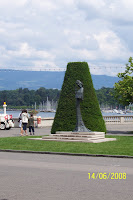
Otherwise, perhaps the reference is to the views of
Mont Salève, a favourite viewing-point the other side of the French border; except you can’t see it from the south side of the Rhône, which is where the “tram” went.
Nor was the tour notably panoramic for quite a while. It went past a number of interesting sights, but usually too fast for photos, and unlike the
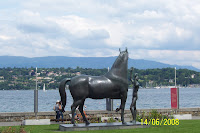
“train” tour, there were no stops for taking photos, except those caused by traffic. It was at such a stop that we took this picture of the elegant memorial to Elizabeth of Austria (“
Sissi”), who was assassinated on the spot in 1898, and, further on, this statue of a naked man apparently making interesting advances towards a naked horse …

Despite its shortcomings, the tour was interesting and covered quite a lot of the city, including parts we recognised because they’d been on our bus route down from the hotel earlier on: the
World Ecumenical Centre and the
UNO  headquarters
headquarters (see the flags!); but mostly the “tram” still moved too fast for much in the way of photos. (This view of the city was snapped from the
Quai Gustave Adore, not far from the
America’s Cup village, during another “traffic stop”.)
The highlight, though, and the point at which the “panoramic” promise was fulfilled, was when we climbed up among the hills to the north-east of the city into
Cologny, an exclusive suburb where only the very rich can afford to live. The road up was itself charming, a country lane weaving between fields and woods, where falcons soared above the trees and meadows. There were many large houses (mansions) just visible behind high walls, and high-powered sports cars passed us uphill or down.
At the top of the hill, the “tram” finally stopped so the passengers could get out for photos. There was a magnificent view over the lake, back to the city, and we took a full panorama of shots, of which this is only the left half:
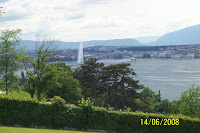


Not only was the view fabulous, there was also an historical mark
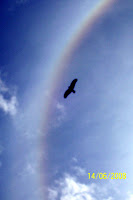
er: an inscribed boulder marking Byron’s meeting with Shelley when they stayed here in 1816. But we forgot to take a photograph of it because we were so distracted by the sight of a solar halo—and wheeling falcons. By the greatest good luck, we managed to get both phenomena in the one shot.
The tram took us back downhill and round to its “home base” at the
Place du Rhône. We were still in the mood for a lake cruise, so we walked back round to the
Départ des Bâteaux, pausing to buy some fridge magnets (no longer magneti in this French-speaking city) from a souvenir stall, and got tickets on the ordinary (no meals) 17:12 cruise round the “lower” lake (the
Petit Lac).
We had some time to spend, so we took coffee and a beer at a bar in the
Jardin Anglais. While waiting, we used the
Rough Guide to Switzerland to help pick a restaurant for dinner. (And that’s also when we took the Floral Clock photo.)

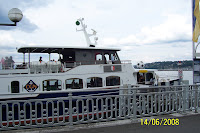
Sadly, we didn’t record the name of the boat, but we did get a photo. We climbed aboard and initially went below decks; but you can’t see much there, and though it was cloudy, breezy and cool by now, it wasn’t raining, so we went above and found seats at the bow.
It would have been lovely if the sun had stayed out, but even without sunshine, it was a relaxing

and enjoyable way to spend three quarters of an hour (as long as we ignored the annoying American accent on the commentary—

not the accent itself, that was fine, but the failure to make any attempt to pronounce French words other than as funny-spelt American English). There was a lot to see around the lake shore, but also lots on and above the water: not only interesting boats and water-skiers, but also more circling falcons, and lots of swallows skimming low over the water.
The boat took us around the lower end of the lake, and across to the other (northern) side, which was very convenient in view of the restaurant we’d chosen for dinner: one that promised to fulfil our wish to end our European holiday with Swiss fondue. We got off at the
Quai Mt Blanc, from where it was only a 10-minute walk to
Au Petit Chalet in the rue de Berne (via
touristiques shops where we bought Swiss chocolates for friends and family).
The restaurant was delightful: “Five years after my last visit—I went there every day—I went back today. The staff has not really changed, but the proprietor yes, very recently. The place is always charming. … I will return to this place, that's for sure, because I remember many good dishes. Above all, the menu is very interesting and varied.”

For entrée, we had
escargots (Margaret; can’t go wrong) and vegetable soup (Don; quite delicious); for mains, we chose
fondue avec champignons: if it weren’t so filling, we could have eaten twice as much. We chatted with the friendly waitress (limoncello, “
elle est très bonne; elle est la liqueur des femmes”), and with the young English couple at the adjoining table: they were moving to Geneva in connection with her job with CERN, and he was going to house-father, so Don was able to describe his own experiences in that role.
Some time later, feeling very satisfied with a very full day, we walked back to the bus stop at
Place Bel Air, mounted another #5 bus, and went back to La Colombière. We had intended to go down to the restaurant for some drinks and to meet “Mike” again (if he was on duty; he hadn’t been that morning), but also in the hope that the family (the Ragnellis) would come in again.
La Colombiere is apparently noted for “
Folklore musette”, which looks like something that would appeal to us …
But it was late, and we were tired after a very busy day, and we did have a near-600 mile journey the next day; and so to bed …
 plan turned out to be travelling home in two days, with a day in Geneva in between. Our task for today: travel more than 500 miles to get to Calais in time for our 6 o’clock-ish ferry home.
plan turned out to be travelling home in two days, with a day in Geneva in between. Our task for today: travel more than 500 miles to get to Calais in time for our 6 o’clock-ish ferry home.

 Net result: France went past in a blur; there are no photos along
Net result: France went past in a blur; there are no photos along the way; we covered 511 miles in 7½ hours; we made the Ferry just in time; and our car had completed 2721 miles of holiday journey … We bade a sad farewell to Calais and Europe; and an hour and a half later, a fond how-d’ye-do to England and the Castle atop the White Cliffs of Dover (somewhat masked by the salt stains on the windows).
the way; we covered 511 miles in 7½ hours; we made the Ferry just in time; and our car had completed 2721 miles of holiday journey … We bade a sad farewell to Calais and Europe; and an hour and a half later, a fond how-d’ye-do to England and the Castle atop the White Cliffs of Dover (somewhat masked by the salt stains on the windows).








 The Vieille Ville is a small but wonderful maze of cobblestoned streets at various elevations,
The Vieille Ville is a small but wonderful maze of cobblestoned streets at various elevations, 










 Not only was the view fabulous, there was also an historical mark
Not only was the view fabulous, there was also an historical mark










